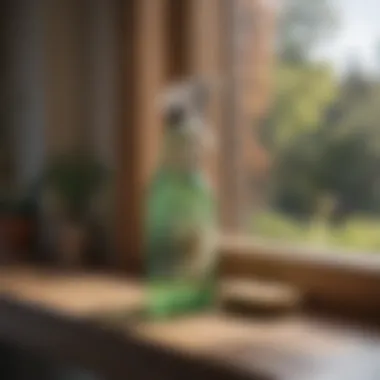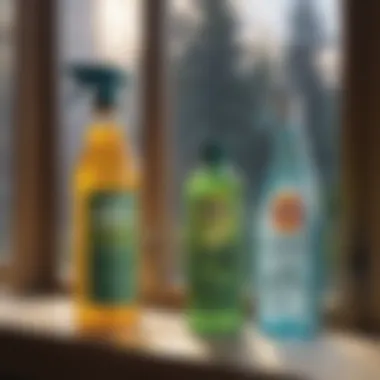Cleaning Windows: Methods and Tools for Clarity


Intro
Window cleaning is often seen as a mundane chore, yet it plays a critical role in maintaining the aesthetic and functional integrity of both residential and commercial spaces. Windows not only enhance the architectural beauty of a building but also serve as a portal to the outside world. Clean windows allow natural light to permeate interiors, creating a sense of warmth and openness. In contrast, dirty windows can make even the most stunning structures look dull.
In this article, we will explore methods and tools used specifically for cleaning windows. From homemade solutions that can be whipped up in your kitchen to commercial products that are tried and tested, we've got you covered. We will also discuss innovative tools that can dramatically improve cleaning efficiency while also considering the environmental impact of various cleaning agents. With more people becoming aware of ecological concerns, choosing the right products for clarity without harming the environment is vital.
As we delve into effective cleaning strategies, readers will gain insight into optimal practices for achieving sparkling windows and the significance of sustainable choices.
Prologue to Window Cleaning
Window cleaning often remains overlooked despite its significant impact on both aesthetics and functionality. The importance of maintainining clean windows cannot be underestimated, especially in residential and commercial settings. Clean windows enhance the overall appearance of a property, inviting natural light to enter and improving indoor mood. Furthermore, windows that are well cared for can contribute to the longevity of the glass and surrounding structures by preventing the buildup of grime and corrosive materials.
In addition to aesthetics, the maintenance of windows is essential for preserving structural integrity. Dirty windows more often accumulate debris, leading to potential damage. Moreover, to achieve optimal clarity and exterior appeal, cleanliness must be frequent and effective.
Effective methods and tools for window cleaning can save time and enhance results. Familiarizing oneself with available cleaning solutions, whether homemade or commercial, plays a crucial role in this area. This section will elaborate on the two primary aspects of window cleaning: importance and common challenges.
Homemade Cleaning Solutions
In the quest for crystal-clear windows, homemade cleaning solutions offer an attractive alternative. These mixtures not only provide effective cleaning but also often involve readily available ingredients. Using such solutions allows for greater control over what enters your home and is typically more cost-effective than commercial products. Furthermore, many of these options steer clear of harsh chemicals, advocating for a sustainable cleaning routine.
Homemade cleaning solutions can be tailored to suit various cleaning needs, presenting flexibility in both formulation and application. Such adaptability makes them appealing to a wide range of users, from busy families to meticulous interior designers. Plus, the satisfaction of creating your own effective cleaning agent cannot be understated.
Vinegar and Water Solution
Vinegar and water is a well-regarded duo for window cleaning. The acetic acid in vinegar works effectively to break down dirt and grime. This solution is also safe for both the environment and the user, making it a favorite among eco-conscious individuals.
To create this mixture, combine equal parts distilled vinegar and water in a spray bottle. Shake gently before use. Apply directly onto the window surface, then wipe with a clean cloth or squeegee. This method provides a streak-free shine that is particularly advantageous when cleaning glass windows.
"Using vinegar not only cleans the surface but also helps to prevent future buildup of grime due to its natural properties."
Dish Soap and Warm Water
Another effective homemade option is a simple mix of dish soap and warm water. This solution is easily accessible and utilizes everyday household items, making it a practical choice. The surfactants in the dish soap aid in breaking down oily residues that may accumulate on windows.
To prepare, mix a few drops of dish soap with a bucket of warm water. Use a sponge or cloth to apply the soapy water directly onto the glass. Follow up with a squeegee for an effective clean. The warm water also assists in loosening tougher stains, enhancing the overall cleaning process.
Baking Soda Paste
Baking soda serves as another excellent option for window cleaning, particularly for removing stubborn spots. This mild abrasive can effectively tackle sticky residues while being gentle on glass surfaces.
To use baking soda, create a paste by mixing it with a small amount of water until a thick consistency is achieved. Apply this paste to the affected areas using a cloth or sponge. After allowing it to sit for a few minutes, rinse with clean water and dry. This technique works well for both windows and frames, resulting in a cleaner, brighter finish.
In summary, homemade cleaning solutions are an accessible and environmentally friendly way to ensure clean windows. Options like vinegar, dish soap, and baking soda provide a variety of cleaning methods to suit different needs and preferences.
Commercial Window Cleaning Products
Commercial window cleaning products are essential for maintaining clarity and shine in both residential and commercial spaces. These products are formulated to tackle stubborn dirt, grime, and streaks that can accumulate on glass surfaces. Utilizing these specialized cleaners often results in a cleaner, streak-free finish compared to homemade alternatives. Additionally, many commercial formulations work faster and require less elbow grease, making them a popular choice for those needing efficient solutions.
When considering the variety of commercial products available, one must acknowledge their role in enhancing aesthetic qualities. Clean windows not only contribute to a more appealing environment but can also have positive psychological effects on inhabitants and visitors alike. Furthermore, businesses benefit from cleaner windows indirectly through improved customer perceptions and an enhanced image.
Understanding Labels and Ingredients
Understanding the labels on commercial window cleaning products is essential for selecting the right solution. Each product may contain different chemicals, which can affect both performance and safety. Common ingredients found in these cleaners include:


- Ammonia: Effective in breaking down grease and grime, but can emit strong odors.
- Isopropyl Alcohol: Often used for its fast-evaporating properties; helps cut through dirt quickly.
- Surfactants: These agents lower the surface tension of water, allowing it to spread and clean effectively.
By reading product labels, customers can better assess whether the cleaner suits their specific needs. Moreover, being informed about potential harmful substances enables consumers to make safer choices for their households or workplaces.
Popular Brands and Their Efficacy
Many brands have established themselves in the window cleaning market, known for their effectiveness and reliability. Some notable names in this space include:
- Windex: Renowned for versatility and quick drying; it is suitable for both glass and multi-surface cleaning.
- Zep: Targets professional-grade cleaning solutions and is often favored in commercial settings.
- Method: Offers eco-conscious options that utilize plant-based ingredients, appealing to environmentally-minded consumers.
Each of these brands brings something different to the table, whether it’s the ease of use, formulation strength, or eco-friendliness. The efficacy of these products can often depend on the cleaning surface, so user reviews may provide valuable insights into their performance.
Eco-friendly Commercial Options
As environmental concerns rise, many brands are responding by developing eco-friendly commercial window cleaning products. These cleaners typically use biodegradable ingredients and represent sustainable alternatives to traditional chemical formulations.
Benefits of choosing eco-friendly options include:
- Reduced environmental impact, leading to less chemical runoff.
- Safer for children and pets, minimizing the risk of exposure to harsh substances.
- Often just as effective as conventional products, maintaining cleaner windows without compromising ecological integrity.
Some notable eco-friendly brands in the market are Seventh Generation and Ecover, both of which focus on natural and safe cleaning solutions. Overall, opting for eco-friendly commercial products can be a wise choice for those looking to combine effective cleaning with sustainable practices.
Tools for Effective Window Cleaning
Window cleaning is not merely about having the right technique; it fundamentally relies on the tools utilized. Proper tools enhance efficiency and lead to better results. When cleaning windows, the choice of tools affects both the quality of the finish and the ease of the job. Investing in good tools can minimize effort and maximize satisfaction with the results.
Efficient window cleaning tools can reduce streaks, eliminate grime, and save time. Selecting tools that match the type of window surfaces and locations is crucial. For instance, using a squeegee can dramatically change how effective your cleaning routine is, especially when paired with the right cleaning solution. Below are the key tools that every window cleaner should consider adding to their arsenal.
Squeegees: Types and Usage
Squeegees are perhaps the most essential tools for window cleaning. Their primary function is to remove water and cleaning solutions from glass surfaces, effectively leaving them streak-free. There are various types of squeegees available.
- Rubber Blades: These are designed specifically for squeegees. They are flexible and provide a smooth glide along the glass. Regular replacement ensures optimal performance.
- Sizes: Squeegees come in different widths. A wider blade can cover more surface area quickly, while a smaller one can give you added control, especially on smaller windows.
- Handles: Some squeegees feature extendable handles which can be helpful for reaching higher windows without a ladder.
Using a squeegee effectively requires technique. It is advisable to start at the top and work your way down, using even pressure to avoid streaks.
Microfiber Cloths
Microfiber cloths are indispensable in window cleaning. Their unique fiber structure allows them to capture dust and dirt rather than simply moving it around. Here’s why they are favored:
- Absorbency: Microfiber cloths can absorb up to seven times their weight in water. This property makes them ideal for absorbing excess cleaning fluid after using a squeegee.
- Gentle on Surfaces: Unlike harsher materials, microfiber will not scratch glass, ensuring your windows remain pristine.
- Durability: They are machine washable and can be reused multiple times, making them an eco-friendly choice.
When utilizing microfiber cloths, consider using them for the final wipe down after squeegee use. This ensures no remnants are left behind, and the windows achieve that crystal-clear finish.
Extension Poles for Hard-to-Reach Areas
Extension poles are crucial for cleaning higher windows that are otherwise difficult to access. They allow users to maintain safety while reaching elevated areas. Here are some considerations:
- Adjustable Length: Many extension poles have adjustable lengths, making them versatile for different window heights.
- Compatibility: Ensure that the pole can easily attach to your squeegee or washer. Some poles come with specific attachments designed for window cleaning, enhancing functionality.
- Material: Lightweight materials like aluminum are preferred as they reduce fatigue when cleaning high windows for extended periods.
When using extension poles, it's essential to maintain stability. Position yourself firmly, and practice using the tools to ensure you can steer them effectively without straining your body.
Important Note: The right tools can greatly enhance the effectiveness of your window cleaning efforts. Choosing quality tools not only improves results but also makes the process more enjoyable and efficient.
Techniques for Window Cleaning


Cleaning windows demands effective methods to achieve desired clarity. Techniques play a crucial role in ensuring that surfaces are not only clean but also free from streaks and smudges. Understanding the various techniques available can enhance both the efficiency and effectiveness of window cleaning tasks. Proper techniques help to minimize physical exertion while maximizing cleaning results.
The Two-Bucket Method
The Two-Bucket Method is a classic yet highly effective technique for window cleaning. This method uses two separate buckets: one for the cleaning solution and the other for rinse water. The advantage of this is to keep dirty water away from the cleaning solution. By doing so, you avoid reapplying dirt back onto the glass, which can result in streaks and a less-than-satisfactory finish.
- Preparation: Fill one bucket with warm water and dish soap, while the second bucket should contain clean water for rinsing.
- Application: Using a sponge or scrubber dipped into the soapy water, apply the solution to the window in a circular motion.
- Rinsing: After applying, rinse the sponge in the clean water bucket before starting the next area of the glass.
- Final Touch: Finally, use a squeegee to remove remaining water and debris. Repeat the rinsing process every few passes with the sponge to maintain cleanliness.
This approach minimizes dirt absorption, promotes a smoother cleaning process, and greatly enhances the likelihood of achieving a streak-free finish.
Cleaning from the Inside vs. Outside
Deciding whether to clean windows from the inside or the outside depends on several factors. There are specific considerations and advantages associated with each approach. Cleaning windows internally often provides easier access and a controlled environment. This allows for detailed cleaning without weather interruptions.
However, exterior cleaning presents unique challenges such as weather elements, high-rise buildings, and dirt accumulation from the outside.
- Internal Cleaning:
- External Cleaning:
- Easier access and control.
- Safer for those on upper floors.
- Potentially less mess, since indoor cleaning usually leads to fewer debris.
- Removes dirt that accumulates on the exterior over time.
- May require safety gear or ladders for high windows.
- Often needs to be done more frequently due to environmental factors.
Balancing how often to clean both sides can help maintain overall clarity.
Avoiding Streaks
Streaks are a common annoyance when cleaning windows. Techniques such as drying with a clean, dry squeegee or cloth can help mitigate streak formation. Here are some methods to avoid streaks:
- Use the Right Tools: Select quality tools, such as a professional-grade squeegee and microfiber cloths, to enhance cleaning efficiency.
- Drying Technique: Always wipe in a continuous motion from top to bottom, as this prevents drips from ruining your progress and keeps a cleaner, clearer line.
- Time of Day: Avoid cleaning in direct sunlight, as it can cause cleaning solutions to dry too quickly, leaving behind streaks.
- Solution Quality: Utilize homemade solutions or reputable commercial products that are designed to provide streak-free results.
“Always take care to use the right techniques, tools, and timing for the best window cleaning outcomes.”
Such measures significantly contribute to achieving a spotless finish and ensuring windows remain clear and attractive for an extended period.
Frequency of Window Cleaning
Understanding the frequency of window cleaning is essential for maintaining not only the appearance of windows but also their longevity. Clean windows significantly enhance the aesthetic appeal of a property, whether residential or commercial. Regular cleaning prevents the buildup of grime, dirt, and pollutants that can lead to more serious damage over time. Moreover, establishing a cleaning schedule tailored to specific conditions and needs can help achieve a more effective and efficient process.
Factors Influencing Cleaning Frequency
Several factors play a crucial role in determining how often windows should be cleaned. Identifying these elements assists in creating a cleaning plan that aligns with your environment and lifestyle. Here are some key factors:
- Location: Areas with high air pollution, such as urban settings, necessitate more frequent cleaning. Dust and vehicle emissions can accumulate quickly on windows.
- Weather Conditions: Rain, snow, and wind can contribute to window soiling. For instance, coastal areas may experience salt spray, while forests may have pollen that settles on glass surfaces.
- Type of Building: Residential homes might require less frequent cleaning compared to commercial properties, where foot traffic and visibility lead to quicker grime buildup.
- Window Material: Glass type can affect how often cleaning is necessary. For example, low-E glass may require different maintenance than regular glass due to its coatings.
Understanding these factors can help in drafting a tailored maintenance schedule.
Seasonal Considerations
Seasons influence window cleaning frequency and practices in various ways. Here are some considerations for each season:
- Spring: With the arrival of warmer weather, a thorough cleaning after winter is beneficial. This removes dirt, debris, and any residual residues that have accumulated. Spring cleaning also prepares windows for the sunny months ahead.
- Summer: High humidity and summer storms can lead to quicker soiling. Clean windows during the summer can boost indoor light and improve overall ambiance.
- Autumn: Falling leaves and increased rainfall may necessitate more frequent cleaning. Dirty windows can hinder the natural beauty of autumn foliage and the crispness of fall light.
- Winter: Ice and snow can damage window seals. While cleaning may be less frequent, taking time to clear snow and ice off windows is important. It prevents water from seeping through cracks during thaw cycles.
Maintaining a seasonal cleaning schedule not only enhances visibility but also supports the overall lifespan of window structures.
Overall, knowing when and how often to clean windows plays an integral part in proper home maintenance. Tailoring the frequency based on specific conditions ensures windows remain in optimal condition, preserving both beauty and functionality.
Safety Measures in Window Cleaning


Cleaning windows can be an important yet risky task, especially when heights are involved. Therefore, ensuring safety measures during window cleaning is not just a best practice but a necessity. Lack of proper precautions can result in accidents or injuries that detract from the benefits of having clean windows. It strengthens the overall cleaning efforts because, without safety, the task can become daunting and dangerous.
Implementing effective safety measures goes beyond simply following guidelines; it embodies a culture of care for oneself and others. It allows individuals to perform cleaning tasks with confidence, knowing they are protected. Additionally, prioritizing safety minimizes the risk of damage to property and ensures that one can complete the task efficiently.
Using Ladders Safely
Ladders are essential tools in window cleaning, particularly for reaching high places. However, their use comes with inherent risks. When using a ladder, it is vital to ensure that it is placed on a stable and flat surface. A slight incline or loose ground can lead to falls. Always check that the locks on the ladder are secure before ascending.
Also, one should not overreach while on the ladder. It is tempting to stretch for that one stubborn spot, but this can significantly increase the risk of falling. Instead, descend and reposition the ladder as needed. It is also advisable to have a spotter—someone who can hold the bottom of the ladder or provide assistance if required.
"Taking safety precautions when using ladders can save you from unnecessary accidents and injuries."
Protective Gear
Wearing protective gear while cleaning windows is often overlooked. Yet, it can greatly reduce the risk of injury. At the very least, sturdy shoes with good grip should be worn. These can prevent slips and falls. Additionally, using gloves can protect your hands from harsh chemicals in cleaning solutions.
Another important aspect is eye protection. Cleaning solutions can cause irritation, especially if they splatter. Therefore, using goggles or glasses can provide a safeguard for your eyes. If working at a significant height, wear a hard hat to protect against any accidental falls or dropped equipment.
In summary, attention to safety measures when cleaning windows not only protects you but also ensures the job gets done without incident. By using ladders properly and donning appropriate gear, window cleaning can become a manageable and safe task.
The Environmental Impact of Cleaning Agents
Understanding the ecological consequences of cleaning agents is essential for anyone concerned about sustainability in their practices. In the context of window cleaning, the use of various chemical solutions can contribute significantly to environmental degradation. This section will explore the implications of chemical runoff and offer biodegradable alternatives that maintain high standards in cleaning efficiency without compromising environmental integrity.
Chemical Runoff and Its Effects
Chemical runoff occurs when cleaning agents used outdoors, such as those for window cleaning, flow into the water system due to rainfall or incorrect disposal. This runoff can contain hazardous substances that may harm aquatic ecosystems. The presence of these chemicals in water bodies can lead to long-lasting impacts on plant and animal life.
Some common implications of chemical runoff include:
- Toxicity to Marine Life: Many chemicals are harmful to fish and other aquatic organisms. This toxicity can disrupt reproduction and growth rates, causing population declines.
- Eutrophication: Excessive nutrients from cleaning agents can lead to algal blooms. These blooms consume oxygen and create dead zones, making survival difficult for marine organisms.
- Contamination of Drinking Water: Runoff can taint local drinking water sources with harsh chemicals, leading to potential health risks for humans.
Proper disposal and reduced usage of harmful chemicals can significantly lessen the negative environmental effects.
Biodegradable Alternatives
Given the potential damage caused by conventional cleaning agents, considering biodegradable alternatives is critical. Such products break down naturally in the environment, minimizing the risks associated with chemical runoff. These eco-friendly cleaning solutions often use natural ingredients that are effective yet safe for both users and ecological systems.
Here are some viable biodegradable alternatives for window cleaning:
- Vinegar-Based Solutions: Vinegar is a powerful cleaning agent that not only cleans glass surfaces efficiently but also leaves no harmful residues behind.
- Baking Soda: This natural compound can help remove stubborn stains and grime while being safe for the environment.
- Plant-Based Detergents: Products derived from plant sources often provide effective cleaning abilities. Their formulations are designed to minimize ecological impact.
Closure and Recommendations
In the world of window cleaning, effectiveness and sustainability are crucial aspects that cannot be overlooked. This article has explored a range of methods and tools that accommodate various preferences and needs. As window cleaning is often an overlooked chore, recognizing its significance can lead to not only improved aesthetics but also increased home value and more positive living environments.
Summarizing Effective Practices
The practices discussed throughout this article range from homemade solutions to commercial products. Each method offers unique advantages:
- Homemade Solutions: Vinegar and water, dish soap and warm water, and baking soda paste are simple yet powerful remedies.
- Commercial Products: Knowledge of product labels helps in selecting effective cleaning agents. Brands like Windex and Zep have proven efficiency.
- Tools: The use of tools such as a squeegee, microfiber cloths, and extension poles greatly enhances the cleaning process. Understanding how these tools work together can maximize results.
In summary, cleaning windows effectively requires a blend of appropriate techniques, tools, and solutions. Understanding your environment and incorporating a method that suits your needs can lead to much more satisfying results.
Encouraging Sustainable Choices
Stress on the necessity of eco-friendly options grows in today’s environmental landscape. The use of biodegradable alternatives to conventional cleaning agents is more than just a trend—it supports a healthier planet. Some key considerations include:
- Chemical Runoff: Be mindful of the effects of traditional chemical cleaning agents on aquatic ecosystems. These substances can harm local wildlife and contribute to pollution.
- Eco-Friendly Products: Many brands now offer biodegradable window cleaning solutions that are just as effective without the detrimental side effects. Researching brands dedicated to sustainability can aid in making informed decisions.
- DIY Alternatives: Utilizing homemade solutions not only reduces waste but also empowers individuals to control the ingredients they use, making cleaning safer for homes, particularly if children or pets are present.
By adopting sustainable practices, individuals can ensure that their pursuit of clarity in windows does not compromise environmental integrity. This commitment not only enhances the immediate space but also contributes positively to the broader community.







